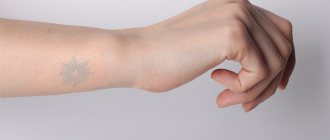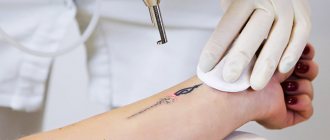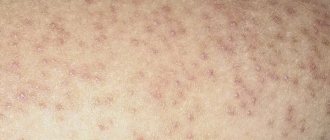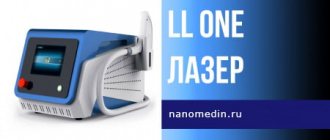Human nature is characterized by periodic rethinking of the action taken. The same is true with tattoos. Of course, they are obviously made for life, but situations often arise when the image simply loses its relevance. Today, laser exposure is recognized as the best way to remove tattoos. As a result of a number of similar procedures, the pattern is eliminated, and the skin remains smooth, without scars or scars. If you look at the results of laser tattoo removal before and after, you can see a dramatic difference.
Types of laser exposure
According to their effects, lasers can be divided into 2 types:
- Ablative effect. There is an impact on an area of skin that can be removed. The skin water instantly heats up and evaporation occurs and, accordingly, the skin with the pattern is eliminated. CO2 laser, erbium and thulium lasers have this effect. Often used to remove old, faded designs.
- Selective influence. A more delicate method that does not result in superficial damage to the skin. Laser beams absorb structures that have been stained and are removed through the lymphatic system.
Tattoo removal
Tattoos owe their origin to small particles entering the epidermis as a result of trauma. Which gives the skin an unnatural and persistent color due to the color of these inclusions. The particle size of tattoo dyes is usually 150-200 microns. This makes it impossible for them to be resorption due to phagocytosis. Sometimes tattoos are burned out with an electrocoagulator, scraped off mechanically (curettage), deep peels are performed, and CO2 laser is removed layer by layer. For some tattoos, another method of removal is not possible, for example, if the dye contains cadmium compounds. However, with such treatment tactics, the dye is completely removed. Removal of a tattoo entails the formation of significant scarring of the skin in the affected area.
How effective is the procedure?
The final result of laser tattoo removal will depend on the device itself and the quality of the work performed. The neodymium laser is recognized as the most effective. It does an excellent job of removing dyes located at different depths due to the ability to use different wavelengths.
The erbium beam is more focused on removing not very deep tattoos by affecting only the upper layer of the epidermis.
Stages of implementation
Laser tattoo removal is carried out in a certain sequence. Qualified specialists strictly adhere to the following stages of the procedure.
- Examination of the patient and setup of equipment, selection of power, wavelength in accordance with skin type, depth of dye.
- Effect on pigment. A laser beam is directed at a specific color of the tattoo. The affected area is divided into microfragments.
- Painkillers and anti-inflammatory drugs are applied to the area where the tattoo is removed. The specialist advises on further care.
A person feels the effect of the laser as a slight burning and tingling sensation, the intensity depends on the sensitivity of the treated area. The duration of the procedure depends on the durability of the ink and the size of the design. Complex multi-color tattoos are removed in several sessions - 7-10.
Positive and negative sides
Known methods of tattoo removal in the form of exposure to liquid nitrogen, burning with acid, and various types of physical impact leave behind extremely unattractive consequences. Laser tattoo removal naturally has a number of advantages over all other existing methods:
- Complete disappearance of the tattoo.
- Spot removal does not affect the skin around the pattern.
- During the procedure there is no severe pain and there is no blood.
- The effect can be observed after the first procedure.
- Modern devices meet all necessary standards.
The disadvantages include the fairly high cost and the time it takes for the tattoo to completely disappear.
Laser tattoo removal: the essence of the method
The high efficiency of laser technologies is based on the natural phenomenon of selective photothermolysis - the process of selective destruction of the tattoo pigment under the thermal influence of induced (forced) light radiation. Its impulses do not cause serious damage to the skin. They act on the pigment of the design, causing it to split into many microparticles, which are gradually absorbed by macrophages (immune cells) and removed from the human body naturally.
You can remove a tattoo with a laser at Alla Khazova’s specialized cosmetology clinic. We are located in Moscow and have a whole arsenal of the latest generation lasers. Taking an individual approach to the problems of each client, we offer European-level service and reasonable prices for procedures. We will discuss the most relevant nuances of their implementation below.
What tattoos can be removed with laser?
The number of fans of body art is growing every day, and along with it, the number of people who want to get rid of unsuccessful, boring tattoos done in youth or in the heat of the moment is also increasing. Please note that removing large tattoos will take longer than removing a small image. In both cases, the procedure is preceded by a consultation with an experienced dermatologist.
The problem is that when a person gets a tattoo, he chooses a design for himself and, as a rule, is not at all interested in the nuances of its application - the composition of the coloring pigment, its density, depth, etc. But they are the ones who determine the choice of laser equipment and the complexity of the upcoming procedure. For example,
- A ruby laser can be used to remove superficial images of black, dark blue, dark green or dark gray;
- an alexandrite laser is excellent for removing dark patterns at a depth of 1.8 mm;
- to reduce dark, deeply located tattoos, a universal neodymium laser is used, etc.
From a theoretical point of view, modern cosmetology has technologies that make it possible to remove any tattoo from a person’s body or face. However, in practice, it can be difficult to achieve complete disappearance of the pattern. As an example, here are a few more common situations.
The easiest way to derive:
- tattoos on areas with a well-formed subcutaneous fat layer - thighs, buttocks, etc.;
- image of a dark color on light skin;
- old drawing (with the exception of “burnt glasses” filled with soot and alcohol).
- It's more difficult to deduce:
- tattoo on the ankle, fingers and other areas with a minimal amount of subcutaneous fat;
- an image made with a dye based on metal oxides;
- intricate, multi-colored design made with durable pigment;
- flesh-colored tattoo, or made in pastel colors, etc.
But even in the most difficult cases, an unwanted pattern can be made almost invisible. To do this, we combine neodymium laser tattoo removal with other cosmetic procedures (fractional skin resurfacing, use of removers, etc.), which allows us to achieve the desired result and preserve the aesthetics of the skin.
How painful is the procedure?
The times when clients of cosmetology clinics had to endure pain have long “sunk into oblivion.” Modern lasers are equipped with a powerful local cooling system, which effectively reduces all painful sensations, and the additional use of local anesthesia allows them to be minimized. Therefore, during the procedure, the client can only feel intense warmth, tingling or a slight burning sensation of the skin at the site of treatment. All sensations are absolutely tolerable and do not cause suffering.
Will there be a scar after tattoo removal and recovery time?
Removing a fresh or old tattoo using a laser is a non-invasive (without damaging the integrity of the skin) cosmetic procedure. As you progress through the entire course of sessions, the unwanted image will become lighter and lighter - until it disappears completely. At first, an inconspicuous light spot or a small shadow may be observed in its place, which gradually disappears on its own.
Proper use of the laser eliminates the risk of scar formation. However, serious side effects are extremely rare. As a rule, their appearance and severity are determined by the individual characteristics of the client’s skin. And even in the absence of such, it is very important to provide the treated surface with proper care:
- the first 24 hours - do not wet;
- for the first 48 hours - do not visit the bathhouse, swimming pool, gym, etc.;
- the first 7 days - treat the problem area of the skin with a solution of Chlorhexidine, Panthenol, Pantestin and (or) other drugs as prescribed by the attending physician, etc.
Once the decision has been made to remove the tattoo from the body, you need to be prepared for the fact that during the entire course of procedures and in the subsequent rehabilitation period (from several months to 1 year), the laser-treated area will need to be protected from exposure to ultraviolet rays and all rules must be observed. doctor's recommendations.
The process of preparing for the procedure
No special preparation is required for the tattoo removal procedure, but some points still require compliance:
- Temporarily exclude the possibility of ultraviolet radiation reaching a specific area of the skin. After this, she may become more sensitive to the laser.
- It is advisable to reduce the dose of nicotine consumed.
- Avoid medications that affect your skin condition.
- It is worth postponing the procedure if there are wounds or inflammation on the skin.
Post-hatch care
After laser treatment, redness and slight swelling appear on the skin, which disappears after a day. Sometimes a crust forms that cannot be picked off. It will disappear on its own in 2-3 days.
Immediately after the procedure, a compress with a special composition is applied to the tattoo site to increase lymph flow and wash out pigment through the pores.
It is recommended to apply compresses for 5 days. Beforehand, the area of tattoo removal is washed with running water and baby soap, and dried with a towel (dry, not rub!). A layer of “Bepanthen” is applied to the skin to eliminate tightness, itching and ensure rapid healing. Cosmetics containing alcohol are contraindicated.
Possible complications and contraindications
There are some contraindications, the presence of which will make laser removal impossible:
- Epilepsy.
- Colds and chronic aggravated diseases.
- Fresh tan.
- Pregnancy and lactation period.
- Cancer diseases.
- Blood clotting problems.
- The presence of inflammation and wounds on the skin.
- Tendency to scar healing.
What influences the effect?
There are several factors that affect lightening a tattoo with a laser:
- The color of the pigment - the darker it is, the easier it is to get rid of it (not to be confused with the amount of pigment under the skin);
- Paint quality. Professional ink is more resistant to the effects of the beam;
- Driving depth. The deeper the dye penetrates, the more sessions should be performed;
- Client's skin color. In fair-skinned patients the process is much simpler;
- Place of tattoo application - designs on the hips, buttocks, legs, chest, thighs and arms are easier to tattoo. But it is more difficult to remove the pattern on the back, fingers or elbows.
Individual consultation
How much will the procedure cost?
Many people are interested in the question of how much it costs to remove a tattoo with a laser. There are factors that can influence the cost in one direction or another:
- Size of tattooed area.
- Depth and color saturation.
- Laser used.
- Professionalism of the master.
Average price per 1 sq. cm is from 300 to 400 rubles, but it may turn out to be less, because the size of the tattoo is also important here. The larger the area to be treated, the cheaper it is.
Each situation is individual and the full cost can only be determined after a personal consultation.
We recommend watching a useful video about laser tattoo removal:
How many sessions are needed?
The number of sessions for complete tattoo removal depends on several factors. First of all, the scale of the image is important - the larger it is, the more times you need to visit a cosmetologist. After all, not only the speed of removal is important, but also the safety of the process. The skin needs restoration between procedures. As a rule, experts recommend taking breaks between visits of 1.5 months.
In addition to size, the brightness of the tattoo and the colors used in it are important. Black contour tattoos are the fastest and easiest to remove; colored tattoos with filling take more time.
In addition to these reasons, the speed of tattoo removal can be influenced by the characteristics of the body - skin color, hormonal levels and other factors. During the course, the cosmetologist will monitor the rate of pigment removal and plan how many more visits may be needed. Taking into account all the conditions, tattoo removal can take from 1 to 8 sessions, and this is approximately 2 times faster and many times more effective than with other devices.











